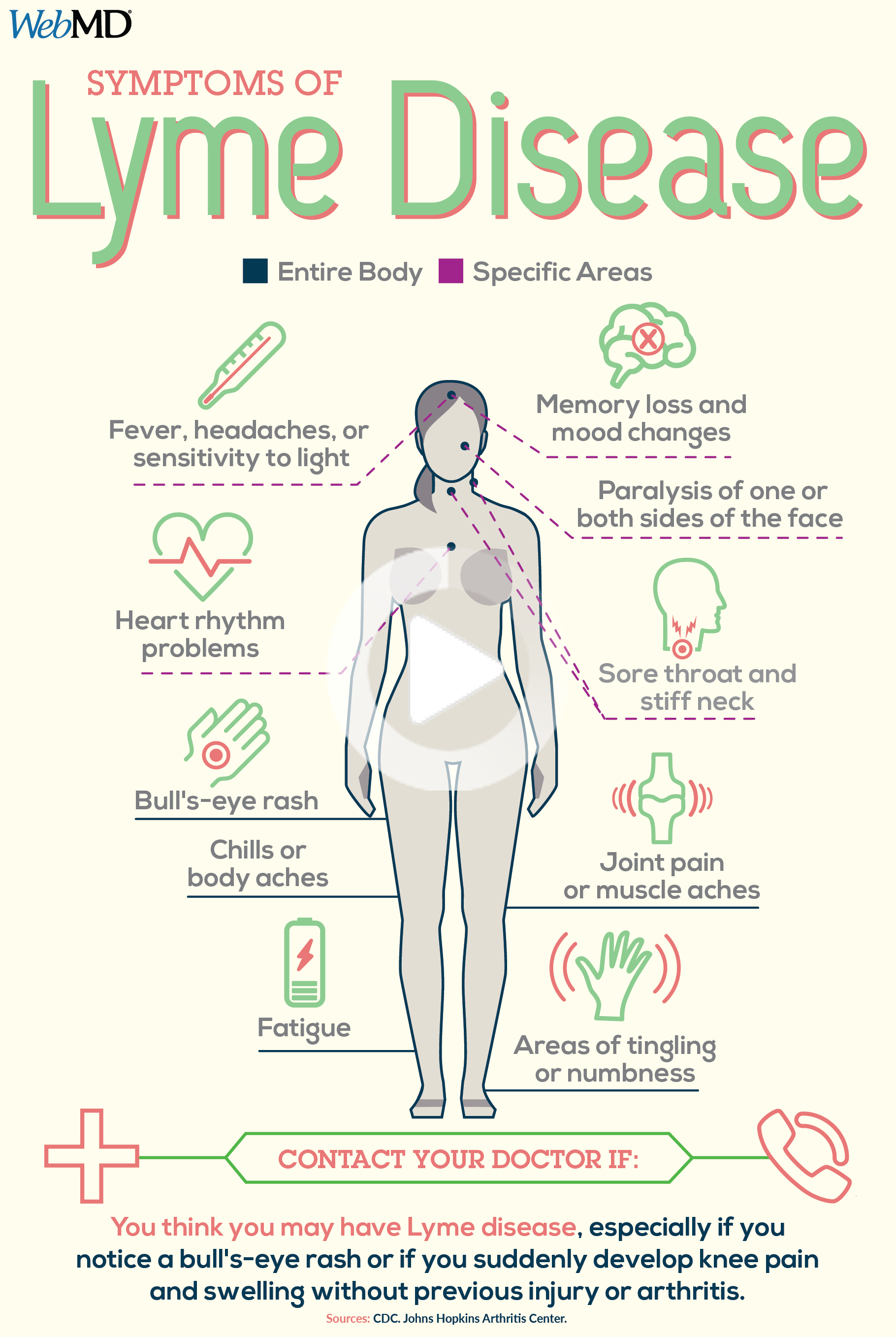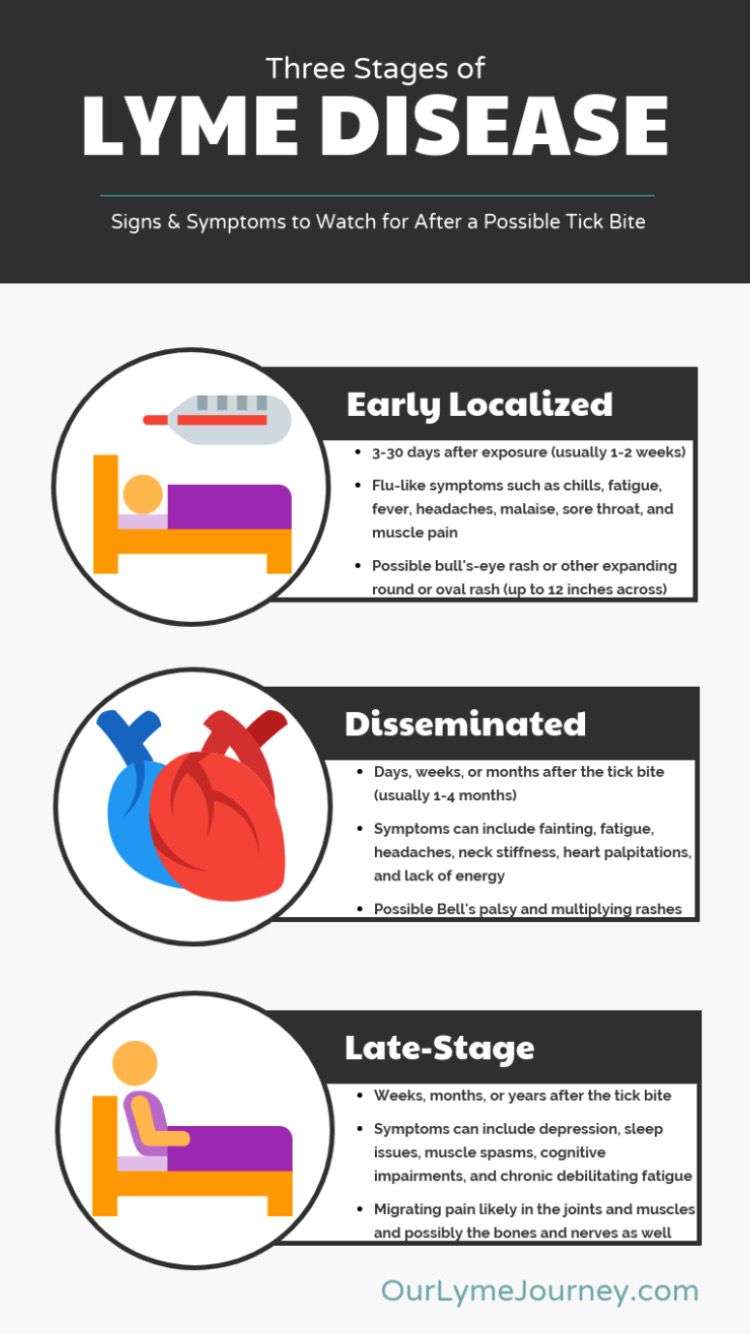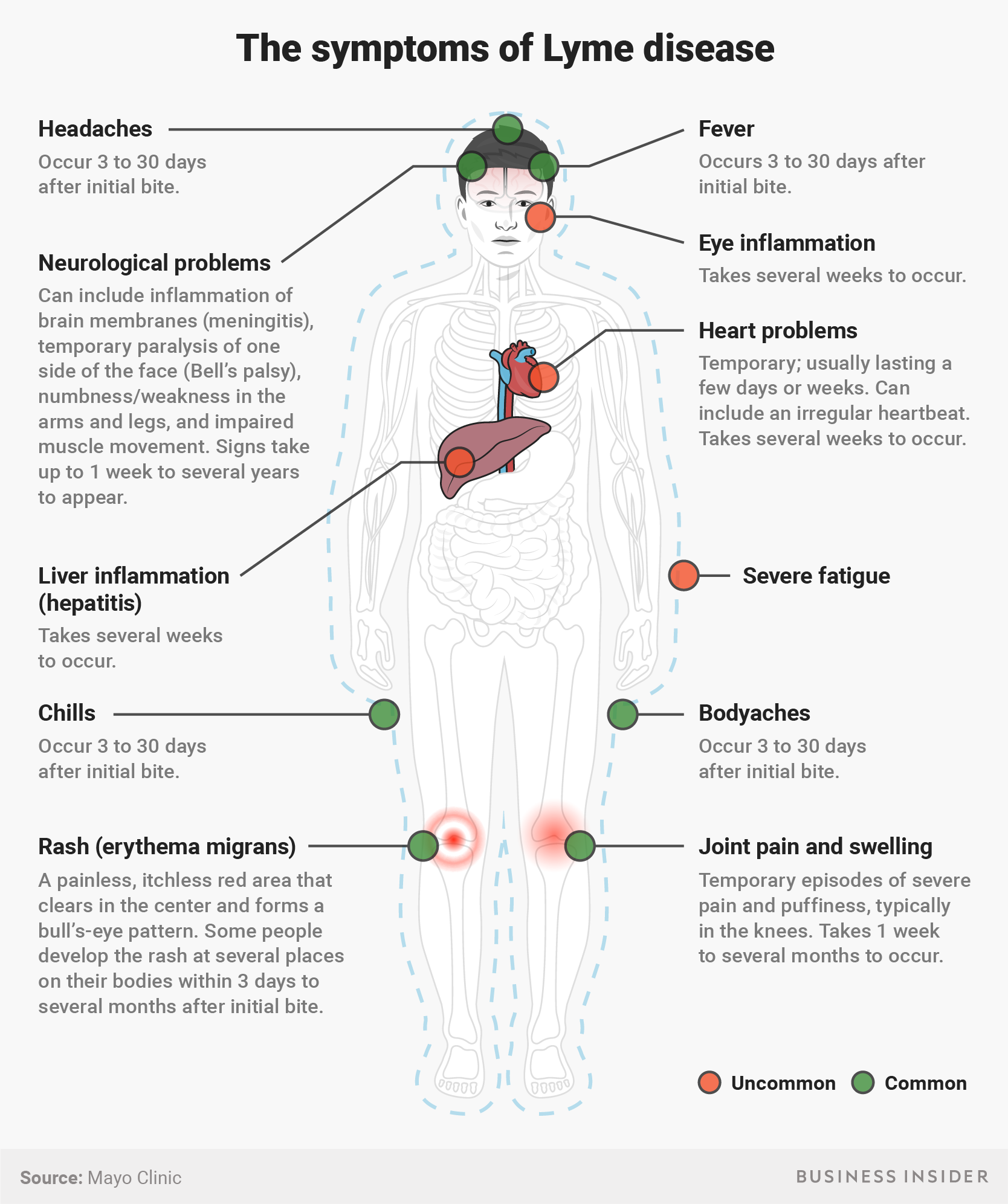What Are The Stages Of Lyme Infection
There are three stages:
- Early localized Lyme: Flu-like symptoms like fever, chills, headache, swollen lymph nodes, sore throat, and a rash that looks like a bull’s-eye or is round and red and at least 2 inches long
- Early disseminated Lyme: Flu-like symptoms like pain, weakness, or numbness in your arms and legs, changes in your vision, heart palpitations and chest pain, a rash , and a type of facial paralysis known as Bellâs palsy
- Late disseminated Lyme: This can happen weeks, months, or years after the tick bite. Symptoms might include arthritis, severe fatigue and headaches, dizziness, trouble sleeping, and confusion.
About 10% of people treated for Lyme infection donât shake the disease. They may go on to have three core symptoms: joint or muscle pain, fatigue, and short-term memory loss or confusion. This is called post-treatment Lyme disease syndrome. It can be hard to diagnose because it has the same symptoms as other diseases. Plus, there isn’t a blood test to confirm it.
Experts arenât sure why Lyme symptoms donât always go away. One theory is that your body keeps fighting the infection even after the bacteria are gone, like an autoimmune disorder.
Which Areas Are More Likely To Have It
The tick that causes Lyme disease has been moving from the Northeast and upper Midwest into the Southern and Western U.S., Mexico, and Canada. Cases in California and Florida are on the rise. After a drop between 2017 and 2018, the numbers jumped a little bit in 2019.
But most Lyme cases in 2019 were in 15 states: Connecticut, Delaware, Maine, Maryland, Massachusetts, Minnesota, New Hampshire, New
Jersey, New York, Pennsylvania, Rhode Island, Vermont, Virginia, West Virginia, and Wisconsin. Washington, DC, is also a hotspot.
In 2019, Pennsylvania had the most Lyme infections, with 6,763. New York was next, with 2,847 cases.
In the Southern U.S., where itâs hotter, ticks stay under leaves so they don’t dry out. This means people donât get Lyme from Southern ticks very often because they don’t usually come out to bite.
Even though people only report about 30,000 cases of Lyme infection in the U.S. each year, there are actually around 476,000 a year. The same tick also can spread other diseases, including babesiosis, anaplasmosis, and Powassan virus. Those diseases are also on the rise in the U.S.
Whoâs likeliest to get Lyme disease?
Boys up to age 15 and men between the ages of 40 and 60 are the most likely to get Lyme disease. Thatâs because they tend to play outside and go camping, hunting, and hiking.
Why are there more ticks now than there used to be?
There are several reasons why Lyme is spreading. Some of these are:
Early Disseminated Lyme Disease
If Lyme disease is left untreated, it may progress to early disseminated Lyme disease, which spreads from the bite location to other parts of the body. It may begin to affect the skin, nervous system, and heart. This stage can occur days to months following the initial infection.Neurologic symptoms occur in approximately 10% of untreated people.
Inflammation of the nervous system can cause:
- Facial paralysis
- Fever
- Numbness, tingling, shooting pain, or weakness in the arms or legs
- Sensitivity to light
- Severe headache or neck stiffness
Lyme carditis, which affects approximately 5% of people in this stage, occurs when the infection reaches the heart tissue and slows down the heart rate too much. Some people may not have any symptoms, while others may experience severe effects requiring hospitalization.
Symptoms include:
- Light-headedness
- Shortness of breath
During this stage, you may develop multiple erythema migrans rashes on areas distant from the original bite. You may also experience headaches, muscle or joint pain, or extreme fatigue.
Early disseminated Lyme disease can be treated with oral or intravenous antibiotics for two or more weeks, depending on the severity of the symptoms.
Read Also: Do Lyme Disease Symptoms Come And Go
Third Stage: Late Disseminated Lyme Disease
The final, and most severe, stage of Lyme disease is the late disseminated stage. At this point, the infection is now considered chronic and the harmful bacteria has made its way throughout the rest of your body.
People may reach this stage if no proper treatment is successfully administered within four months of being infected. When Lyme disease has reached this point, it can greatly affect your quality of life and make everyday activities and movements very painful and difficult. Stage-three Lyme disease can affect almost every aspect of your life, from your gut health and hormone levels to your immune system and heart condition.
Many of the symptoms listed in stage two progress to a more serious state. For instance, joint pain can develop into chronic arthritis, most often in the knees. Numbness and tingling sensations can spread to other parts of your body, like your back, hands, and feet.
Brain fog symptoms are likely to worsen, making it increasingly difficult to recall certain events or to remain concentrated on one task. You may even experience problems speaking and continue to struggle getting decent sleep at night. Some people with experience mood issues with Lyme disease that can make you feel like you have depression or anxiety which may not be connected to a psychiatric disorder and can lead to a misdiagnosis from a mental health professional.
The Lyme Borreliosis Spatial Footprint In The 21st Century: A Key Study Of Sloveniayour Browser Indicates If You’ve Visited This Link

Slovenia is an endemic region for Lyme borreliosis and one of the countries with the highest incidence of this disease on a global scale. Thus, the spatial pattern of Slovenian Lyme borreliosis prevalence was modelled with 246 indicators and transformed into 24 uncorrelated predictor variables that were applied in geographically weighted regression and regression tree algorithms.
Europe PMC
Read Also: Prophylactic Treatment For Lyme Disease
How Do Doctors Diagnose Lyme Disease
In areas where the ticks that carry Lyme disease are found, when a patient comes to a doctor with probable erythema migrans , blood tests are performed to diagnose the condition, including the following:
- Step 1: Enzyme immunoassay or immunofluorescence assay — total Lyme titer or IgG and IgM titers
- Step 2: Western blot testing — only performed if step 1 test results are positive
Other tests that may be indicated include the following:
- Joint aspiration to see if there is another cause for fluid buildup on the joints
- Cerebrospinal fluid analysis in patients with meningitis
- Electrocardiogram to identify Lyme carditis or arrythmias
Stage : Early Disseminated Lyme Disease
Early disseminated Lyme disease occurs several weeks to months after the tick bite.
Youll have a general feeling of being unwell, and a rash may appear in areas other than the tick bite.
This stage of the disease is primarily characterized by evidence of systemic infection, which means infection has spread throughout the body, including to other organs.
Symptoms can include:
- disturbances in heart rhythm, which can be caused by Lyme carditis
- neurologic conditions, such as numbness, tingling, facial and cranial nerve palsies, and meningitis
The symptoms of stages 1 and 2 can overlap.
You May Like: When Should You Get Tested For Lyme Disease
Achy Stiff Or Swollen Joints
Joint pain and stiffness, often intermittent, are early Lyme symptoms. Your joints may be inflamed, warm to the touch, painful, and swollen. You may have stiffness and limited range of motion in some joints .
Pain may move around. Sometimes your knees may hurt, whereas other times its your neck or your heels. You may also have bursitis . Bursae are the thin cushions between bone and surrounding tissue.
The pain may be severe, and it may be transitory. More than one joint may be affected. Most often the large joints are involved .
People often attribute joint problems to age, genetics, or sports. Lyme should be added to that list, as these statistics indicate:
- One study estimates that 80 percent of people with untreated Lyme have muscle and joint symptoms .
- Fifty percent of people with untreated Lyme have intermittent episodes of arthritis .
- Two-thirds of people have their first episode of joint pain within six months of the infection .
- Use of anti-inflammatory drugs may mask the actual number of people with joint swelling .
Summary:
Joint pain that comes and goes, or moves from joint to joint, could be a sign of Lyme.
Central Mass Residents Must Protect Themselves From The Threat Of Infection With Effective Tick Control
Professional Central Mass tick control is our best ally in the fight against tick bites, and it is available all year long. In the spring, summer, and fall, barrier tick spray is an essential part of Lyme disease prevention. In the late fall and through the winter, tick tubes will carry on the fight, decreasing the number of ticks that will emerge in the spring.
Don’t Miss: Dr Jay Davidson Lyme Disease
When Should You Call Your Doctor
- A tick is attached to your body and you are unable to remove the entire tick.
- You have a circular red rash that expands over the course of several days, especially if you know you were recently exposed to ticks. You may also have flu-like symptoms, such as fatigue, headache, stiff neck, fever, chills, or body aches.
- You feel very tired or have joint pain , irregular heartbeats, severe headache, or neck pain.
- You are pregnant or nursing and you think you may have been exposed to ticks.
Stage : Early Disseminated Lyme
This stage of Lyme disease happens weeks or months after a bite from an infected deer tick. Symptoms in this stage are a bit different and can be more sever than in stage one, because the bacteria is spreading through the body. In stage two, patients can experience fever, conjunctivitis, memory loss, interrupted sleep, mood swings, and numbness in extremities. Sufferers might feel as if they have a severe case of flu in stage two.
Recommended Reading: Test Tick For Lyme Disease Massachusetts
How To Avoid Tick Bites
To reduce the chance of being bitten:
- cover your skin while walking outdoors and tuck your trousers into your socks
- use insect repellent on your clothes and skin products containing DEET are best
- stay on clear paths whenever possible
- wear light-coloured clothing so ticks are easier to see and brush off
When Should You See A Doctor If You Think You Have Lyme

The rash is a pretty good indication that you may have been bitten. Take a photo of the rash and see your doctor. At this stage, treatment with antibiotics will probably work.
If you don’t have the rash but have symptoms like fatigue, fever, and headache but no respiratory symptoms like a cough, you may want to talk to your doctor.
Recommended Reading: Symptoms Of Lyme Disease In My Dog
Lyme Disease Symptoms In Humans
Disease symptoms can be very different depending on the form and stage of the disease. So many people dont show any at first Disease symptoms.
- Often one develops at the bite site erythema, that is slowly spreading and growing .
- Flu complaints such as Headache and body aches and fever as Lyme disease symptoms in humans. Lyme disease is therefore often mistaken for summer flu.
- The borrelia can also spread through the blood in the body and later in the course of the disease organs affected. The corresponding Lyme disease symptoms are not noticed until weeks after the infection.
- An acute one Neuroborreliose develops as soon as the infection passes to the nervous system. In rare cases, Borrelia can also affect the heart muscle.
Untreated Lyme Disease Frequency
Its difficult to get exact numbers when it comes to Lyme disease, in part because theres only limited accounting of the conditions frequency overall, and its often misdiagnosed or mistaken for other conditions.
Currently, its estimated that 476,000 people develop it in the United States every year, with 81% of the cases clustered in the Northeast, upper Midwest, and mid-Atlantic regions.
A significantbut shrinkingproportion of those with the disease end up progressing without treatment. Current estimates are hard to come by. In 2012, researchers estimated that about 16% of Lyme disease cases present without rashincreasing the chance that the case is missed, overall. From 1.6% to 7% of all infections have no symptoms.
Knowledge and awareness of this disease have grown over the past couple of decades, greatly improving outcomes. This improving prognosis is associated with better care and detection, leading to timelier intervention.
If you live in a hot spot area for black-legged ticks, never hesitate to reach out to your healthcare professional if youre feeling sick or have a rash.
Read Also: Can You Donate Plasma If You Have Lyme Disease
How Do I Remove A Tick
You should know how to remove a tick just in case one lands on you or a friend. To be safe, remove the tick as soon as possible.
If you find a tick:
- Use tweezers to grasp the tick firmly at its head or mouth, next to your skin.
- Pull firmly and steadily on the tick until it lets go of the skin. If part of the tick stays in your skin, don’t worry. It will eventually come out. But call your doctor if you notice any irritation in the area or symptoms of Lyme disease.
- Swab the bite site with alcohol.
Note: Don’t use petroleum jelly or a lit match to kill a tick. They won’t get the tick off your skin quickly enough, and may just cause it to burrow deeper into your skin.
What Are The Signs & Symptoms Of Lyme Disease
Lyme disease can affect different body systems, such as the nervous system, joints, skin, and heart. The symptoms of Lyme disease are often described as happening in three stages. Not everyone with Lyme has all of these, though:
The rash sometimes has a “bull’s-eye” appearance, with a central red spot surrounded by clear skin that is ringed by an expanding red rash. It also can appear as an growing ring of solid redness. It’s usually flat and painless, but sometimes can be warm to the touch, itchy, scaly, burning, or prickling. The rash may look and feel very different from one person to the next. It can be harder to see on people with darker skin tones, where it can look like a bruise. It gets bigger for a few days to weeks, then goes away on its own. A person also may have flu-like symptoms such as fever, tiredness, headache, and muscle aches.
Recommended Reading: Academic Rentals Old Lyme Ct
Can Lyme Disease Be Prevented
There’s no sure way to avoid getting Lyme disease. But you can minimize your risk. Be aware of ticks when you’re in high-risk areas. If you work outdoors or spend time gardening, fishing, hunting, or camping, take precautions:
- Wear closed shoes or boots, long-sleeved shirts, and long pants. Tuck your pant legs into your shoes or boots to prevent ticks from crawling up your legs.
- Use an insect repellent containing 10% to 30% DEET .
- Wear light-colored clothing to help you see ticks more easily.
- Keep long hair pulled back or wear a hat for protection.
- Don’t sit on the ground outside.
- Check yourself for ticks regularly both indoors and outdoors. Wash your clothes and hair after leaving tick-infested areas.
If you use an insect repellent containing DEET, follow the directions on the product’s label and don’t overapply it. Place DEET on shirt collars and sleeves and pant cuffs, and only use it directly on exposed areas of skin. Be sure to wash it off when you go back indoors.
No vaccine for Lyme disease is currently on the market in the United States.
What Do You Do If There’s A Tick Under Your Skin
Use a pair of fine-tipped tweezers to remove it as soon as possible. Pull upward with steady pressure. If parts of the tick are still in your skin, try to get those with the tweezers, too. After everything is out, clean the bite area with rubbing alcohol or soap and water.
You probably wonât get infected if you remove the tick within 36 to 48 hours.
How do you throw away a tick?
Put it in soapy water or alcohol, stick it to a piece of tape, or flush it down the toilet.
Read Also: Old Lyme Beach House Rentals
Alternative Treatment Of Lyme Disease With Allicin
Allicin is ideal for treating Lyme disease and shows an alternative, highly effective treatment to antibiotics. Since Allicin forms a connection with water, it can effortlessly cross the blood-brain barrier and thus also helps in the 2nd and 3rd stages of Lyme disease. Most common antibiotics hardly show any effect at these stages.
Disease Symptomsin The Early Phase

Many cases of Lyme disease are overlooked, especially in the early phase, since no measurable antibody levels against Borrelia are formed within the first few weeks. Therefore, the result of a blood test should not be awaited in the early stages, but antibiotic therapy should be started immediately if there is clinical suspicion, since the chances of a cure are greatest with early Lyme disease treatment.
It is all the more important that Watch the tick bisstellle closely and at the first signs of a blush that leads to Lyme disease symptoms What counts in people is to see a family doctor. It can also happen that the blush does not form. Then the Lyme bacteria can spread undetected in the body and the infection only becomes a later one time discovered.
RELATED ITEMS
Recommended Reading: East Lyme Homes For Sale